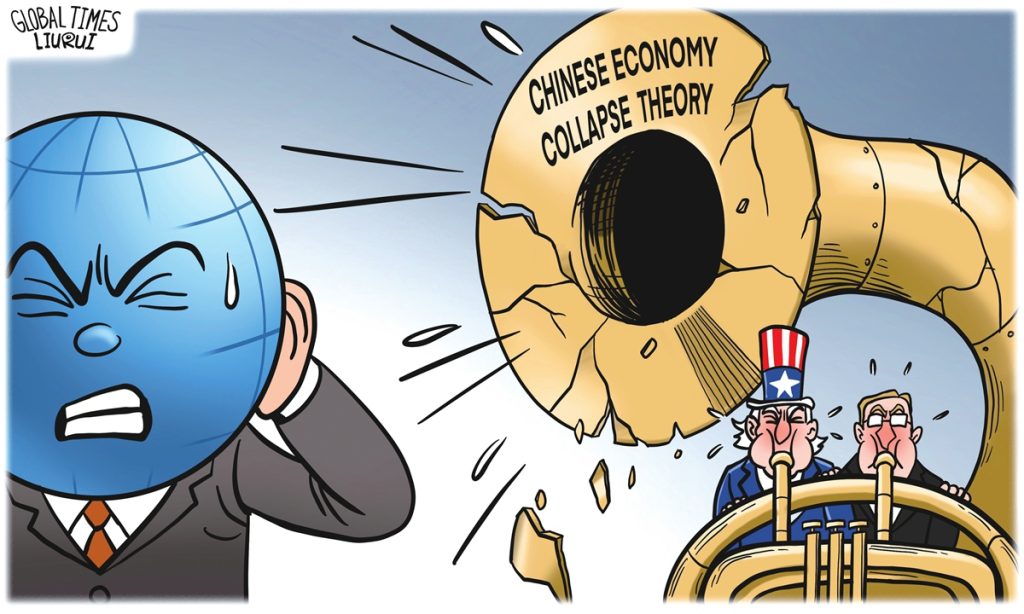GT Voice: Does China’s economy need stronger stimulus to hit growth target?

Whether the Chinese economy needs a stronger stimulus to achieve its growth target this year has become a focus of attention for some Western media outlets, especially after the Government Work Report was submitted to the national legislature for deliberation on Tuesday.
With relatively weak fiscal stimulus, it will be challenging for the economy to meet its 2024 growth target of about 5 percent, a report from the Chinese edition of VOA said on Tuesday. The report noted that it remains uncertain whether future fiscal stimulus spending will be strong enough to overcome difficulties like "sluggish consumption, a property bubble and the local debt crisis."
According to the Government Work Report unveiled at the opening meeting of the second session of the 14th National People's Congress, the nation's proactive fiscal policy and prudent monetary policy will continue in 2024, with enhanced consistency of the macro policy orientation.
China has set a deficit-to-GDP ratio for this year at 3 percent, meaning that the deficit is expected to reach 4.06 trillion yuan ($560 billion), an increase of 180 billion yuan from the deficit target for 2023 set at the beginning of last year.
The Western media's conclusion that the 3 percent deficit-to-GDP ratio is relatively weak stimulus is actually a hint of Western pessimism about the Chinese economy. Usually, only greater economic challenges call for a larger-scale fiscal stimulus.
However, while the deficit-to-GDP ratio is an important indicator of a government's fiscal policy strength, it cannot fully represent China's fiscal expansion or stimulus.
This year's deficit ratio target is slightly lower than the adjusted deficit ratio of 3.8 percent last year, caused by the issuance of an additional 1 trillion yuan in special-purpose treasury bonds. But it is arbitrary to simply view the fiscal support for the economy as inadequate, because there are other policy tools that can be used to support the economy.
A steady and appropriate deficit ratio is in line with the overall recovery of the economy, sending a positive signal to the outside world and showing confidence that China can handle problems at its own pace.
The Chinese economy is entering a critical period of transitioning toward high-quality development. During the process, it is inevitable for the economy to encounter problems and challenges, especially amid a complicated and volatile international environment. But that doesn't change China's long-term economic fundamentals, which remain resilient and are full of positive factors.
Last year, China's GDP grew 5.2 percent year-on-year, higher than the estimated global growth rate of about 3 percent, contributing more than 30 percent of the world's economic growth. Although some countries have been promoting a "decoupling" strategy to contain China's technological development, they cannot stop China's pace of technological innovation and industrial upgrading.
China is gradually transforming from a pattern of traditional manufacturing to high value-added, high-tech sectors, with the digital economy and green and low-carbon industries developing vigorously. In 2023, led by new-energy vehicles, China overtook Japan as the world's largest car exporter for the first time.
No matter how hard some Western media outlets play up the "China collapse" theory, the fact that the Chinese economy can maintain its recovery momentum and achieve its annual growth target despite negative factors at home and abroad is the best proof that its economic development remains stable and resilient.
In this context, simply measuring China's stimulus for economic growth in terms of the deficit ratio is clearly a misunderstanding of the Chinese economy. Whether it is fiscal policy, monetary policy or structural reform, the ultimate goal of policy measures is to support targeted economic transformation and effectively stabilize economic growth, rather than create extra risks with excessive stimulus.